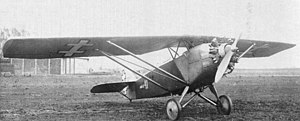| ANBO III | |
|---|---|
 ANBO III with Walter Mars engine | |
| General information | |
| Type | Military advanced trainer aircraft |
| Manufacturer | Karo Aviacijos Tiekimo Skyrius |
| Designer | |
| Number built | 9 |
| History | |
| First flight | 1929 |
| Developed from | ANBO II |
| Developed into | ANBO IV |
The ANBO III was a parasol-wing monoplane training and utility aircraft designed for the Lithuanian Army in 1929. It became the first aircraft of Lithuanian design to be built in series, with two batches of four aircraft produced in 1930 and 1931. The ANBO IIIs also saw service as reconnaissance machines. [1]